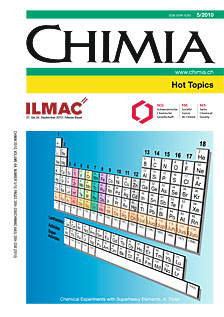Chemical Experiments with Superheavy Elements
DOI:
https://doi.org/10.2533/chimia.2010.293Keywords:
Relativistic effects, Superheavy elements, TransactinidesAbstract
Unnoticed by many chemists, the Periodic Table of the Elements has been extended significantly in the last couple of years and the 7th period has very recently been completed with eka-Rn (element 118) currently being the heaviest element whose synthesis has been reported. These 'superheavy' elements (also called transactinides with atomic number ? 104 (Rf)) have been artificially synthesized in fusion reactions at accelerators in minute quantities of a few single atoms. In addition, all isotopes of the transactinide elements are radioactive and decay with rather short half-lives. Nevertheless, it has been possible in some cases to investigate experimentally chemical properties of transactinide elements and even synthesize simple compounds. The experimental investigation of superheavy elements is especially intriguing, since theoretical calculations predict significant deviations from periodic trends due to the influence of strong relativistic effects. In this contribution first experiments with hassium (Hs, atomic number 108), copernicium (Cn, atomic number 112) and element 114 (eka-Pb) are reviewed.Downloads
Published
2010-05-26
Issue
Section
Scientific Articles
License
Copyright (c) 2010 Swiss Chemical Society

This work is licensed under a Creative Commons Attribution-NonCommercial 4.0 International License.
How to Cite
[1]
A. Türler, Chimia 2010, 64, 293, DOI: 10.2533/chimia.2010.293.







